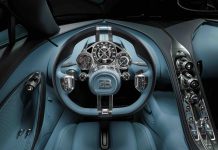When you screw up and the boss – or a client or a customer – loses faith in you, it’s imperative to do more than just what’s expected next time.
If there is a next time.
Mitsubishi – struggling to stay afloat in the wake of the Depreciation Disaster triggered by the infamous “0-0-0” (take a new car home with nothing down and no payments or interest for a year… yeah, that’s the ticket!) marketing scheme it floated a few years back that cratered the resale value of used Mitsus – and by dint of that discouraged sales of new ones – wants to convince you to buy a new Outlander instead of a new Toyota RAV4, Honda CR-V or Hyundai Sante fe.
This new Mitsu – one of the first new Mitsus in several years – does have some definite pluses, including almost-mid-sized dimensions (and standard third-row seating) for about the same money you’d pay for a smaller, two-row-only RAV4 or Honda CR-V and whole lot less money than you’d pay to get into a three-row/seven-passenger, mid-sized crossover SUV like the Hyundai Sante Fe GLS, which starts at $28,600 – vs. just under $23k for the Outlander.
The new Outlander also offers equipment and features not yet commonly found in lower-priced crossovers – including active cruise control, a lane departure warning system and a collision warning system.
It can also be equipped with a driver-selectable, multi-mode AWD system that provides more versatility and capability than the full-time, non-adjustable AWD systems used in most other crossovers in this price range.
However, there are some definite minuses to take into account, too – including a wheezy (and noisy) base engine.
It remains to be seen whether the pluses will outweigh the minuses in the eyes of potential buyers.
WHAT IT IS
The Outlander is a slightly larger than compact – but not quite mid-sized – crossover SUV that offers more seating capacity than two-row-only compact crossovers in a smaller overall package than a fully mid-sized crossover.
It also emphasizes sporty looks and handling over day-to-day utility. 
The new Outlander is available with either FWD or AWD and either an economy-minded 2.4 liter four-cylinder engine or a 3.0 liter V-6.
Base price for the FWD ES with 2.4 liter engine and CVT tansmission is $22,995 – vs. $28,600 for the three-row version of Hyundai’s Sante Fe – and $23,300 for the two-row-only Toyota RAV4.
A top-of-the-line Outlander GT with the V-6 starts at $27,795.
Later in the model year, Mitsubishi will add a hybrid version of the Outlander to the lineup; it will be reviewed separately.
The ’14 Outlander is significantly updated for the first time in several years – both mechanically and cosmetically. Third row seating is now standard and both the standard and optional engines are more fuel-efficient than previously.
WHAT’S GOOD
MSRP-wise, it’s one of the least expensive ways to get into a new three-row crossover SUV.
About 200 pounds lighter than before.
Excellent high-speed stability on gravel/dirt roads; very good ride quality on those roads, too.
Higher-than-typical ground clearance and multi-mode AWD system should give it an advantage in snow and enable it to deal with standing water better than models with less sophisticated AWD systems – and less ground clearance – like the RAV4, CR-V and Sante Fe.
High-end electronics available, including voice-recognition GPS, lane departure warning, adaptive cruise control and collision avoidance.
WHAT’S NOT SO GOOD
Base engine is a underpowered – and over-loud.
Third row is – mostly – for looks (and small kids) only.
Second row legroom has been sacrificed to accommodate the third row.
Mitsubishi might not make it – in which case resale value of models like the Outlander will dive like the Titanic.
UNDER THE HOOD
The ’14 Outlander, like the outgoing Outlander, is available with either a 2.4 liter four or (optionally) a 3.0 liter V-6.
Both engines have been down-tuned a little relative to last year.
The standard single overhead cam 2.4 liter engine now makes 166 hp – vs. 168 last year. This is a bit on the weak side relative to others in this class. The physically smaller Hyundai Sante Fe, for instance, comes standard with 190 hp. The RAV4’s standard engine makes 176 hp.
The CR-V has 185.
On the upside, gas mileage is better than before: 25 city and 31 highway now vs. 23 city, 28 last year. This is slighter better than the RAV4 (24 city, 31 highway) and CR-V (23 city, 31 highway) and a bit more than just slightly better than the base-engined Sante Fe (21 city, 29 highway).
Cresting 30 MPG is important both in terms of marketing, vis-a-vis the competition – as well as vis-a-vis the government’s fuel economy standards. In just two years’ time, 35.5 MPG – average – will be the mandatory minimum.
And, performance is on par with the small crossovers just mentioned – probably because despite being down a bit on power, the ’14 Outlander is a couple hundred pounds lighter than the old Outlander – and (surprisingly) lighter than the physically smaller RAV4 (3,274 lbs. for the Outlander vs. 3,435 for the Toyota).
Ditto the Honda CR-V, though not by quite as much (the Honda weighs in at 3,305 lbs.).
Zero to 60 in the 2.4 liter Outlander takes just over 9 seconds – which is a bit slow-pokey compared with the typical new car but it’s right there with the performance of compact, four-cylinder crossovers like the RAV4 and CRV (9.1 and 9.4 seconds to 60, respectively) and also the Hyundai Sante Fe Sport (the smaller one, not the seven passenger GLS – which only comes with a V-6 engine).
The Outlander’s optional V-6 is likewise down a little on rated horsepower – 224 now vs. 230 last year. But – again – the upside is slightly more economical operation: 20 city, 28 highway – vs. 19 city, 25 highway before – and par for the class acceleration. 
The V-6 is paired with a conventional (hydraulic) six-speed automatic and is capable of getting the Outlander to 60 in about 8 seconds flat – a bit less quick than the V-6 Sante Fe GLS (7.6-7.7 seconds) but much quicker than the four-cylinder-only RAV4 and CR-V.
Fuel economy with the 3 liter V-6 is is 20 city, 28 highway – which is actually slightly better than the three-row/seven passenger Sante Fe GLS with 3.3 liter V-6. The Hyundai rates 18 city, 25 highway with FWD – and 18 city, 24 highway with AWD.
A major draw – relative to the competition – is the Outlander’s more sophisticated Super All-Wheel-Control (S-AWC) AWD system, which has four driver-selectable settings that can be adjusted to suit different conditions such as snow or driving off-road on gravel/dirt roads. The other crossovers in this segment have non-adjustable, “one-size-fits-all” AWD systems that transfer power from the dominant front wheels to the rear wheels when the front wheels begin to slip – with most of the power (typically 90 percent) going to the front wheels most of the time. The Mitsu S-AWD system, in contrast, can lock the power split for superior tenacity in heavy snow or mud – and (when in ECO mode) can divert virtually all the power to the front wheels, to maximize economy. 
The Oultander’s maximum tow rating, when ordered with the V-6 engine, is 3,500 lbs. – stronger than the four-cylinder-only RAV and CR-V (which can only pull 1,500 lbs.) but not as strong as the V-6 Sante Fe, which can tow up to 5,000 lbs.
ON THE ROAD
Hits – and misses.
The Outlander equipped with the 2.4 liter four is under-engined. 166 hp is enough to get 3,274 lbs. moving . . . eventually.
And noisily.
This thing makes a racket – and that (more than the actual performance) is a problem.
Two factors beyond an insufficiency of horsepower can be credited.
First, the continuously variable (CVT) transmission that’s standard equipment with the four. CVTs are gear-less and so shift-less. Instead of using the mechanical leverage of several forward gears to accelerate the vehicle (as with a conventional automatic or manual transmission), the CVT is designed to let the engine rev up to where it makes adequate power – and keep it in that range. But if there’s not much power being made – and if it’s only being made at high RPM – the CVT will hold the engine at high RPM for as long as it takes to achieve the speed you’re trying to reach – or as long as you keep your foot in it.
The 2.4 liter engine makes its peak horsepower at 6,000 RPM (and peak torque at 4,200 RPM). Anything more than the gentlest pressure on the pedal and the CVT kicks the RPMs up – and keeps them up – in order to keep the Outlander moving. Once you’ve achieved say 65 MPH – and assuming the road you’re on is pretty level – you can back off the gas and the racket will die down to manageable levels.
But if there’s a grade – or you need to pick up the pace – the racket will resume.
More sound deadening material would surely help. But that would add to the curb weight – hurting the performance.
What the Outlander really needs is a stronger base engine.
The optional V-6 is an almost-mandatory upgrade. On the plus side, it provides class-competitive acceleration, without the racket. However, Mitsubishi arguably should have upped the performance ante a little – even if it cost a few MPGs. The Outlander is, after all, supposed to be a sportier-than-thou crossover.
One area where the Outlander is clearly better than the competition – based on my own experience driving it and driving competitor models like the RAV and Sante Fe – becomes apparent when the pavement ends.
There is a an old fire road in my area – a single narrow lane of gravel, ruts and mud, with no guardrail and a sheer drop into the woods off to your right. It’s my own private Pike’s Peak – and home turf for the Outlander, as it turned out. Don’t forget that Mitsu builds the World Rally Championship winning EVO, which boasts perhaps the most serious AWD system available for public consumption. The Outlander’s system isn’t the same, but it shares the same development origins – and the brains behind that. Suffice to say, it gits ‘er done. You can really haul the mail on gravel in this thing – Travis Pastrana-style drifting and rooster-tailing it all the way up the mountain. The only letdown is there’s not enough power on tap to explode out of a corner – like you can in an EVO.
But, it’s so smooth.
I happened to get a new Toyota Tacoma truck the week after I had the Outlander. Its solid axle rear suspension (and body-on-frame construction) oscillated like a ship’s bell after being hit with a ball peen hammer – while the Outlander simply skimmed over the washboards and ruts with almost no vibration through the steering wheel – and no sense that your fillings were in danger of being jostled loose from your teeth.
I didn’t get a chance to drive the Outlander in the snow, but with 8.5 inches of clearance (vs. 6.3 for the RAV4 and 7.3 for the Sante Fe) I expect it’d be better than par on that score, too.
The new front clip is more Domo Arigato Mr. Roboto than ’80s-era Cylon Centurion. But the main standout here is the standard three-row seating in a package that straddles the line, footprint-wise (and price-wise) between a compact, two-row-only crossover SUV like the RAV4 and a mid-sized unit like the long-wheelbase Sante Fe GLS.
The Outlander is 183.3 inches long – making it about four inches longer overall than the RAV4 (179.9 inches) and about 10 inches shorter overall than the three-row Sante Fe GLS (193.1 inches).
The Outlander’s third row may be cramped – and it’s not easy to access – but it’s there – vs. nonexistent in the RAV4 and short-wheelbase Sante Fe Sport. And it’ll cost you many thousands less to get than it would in the $28,600 to start Sante FE GLS.
Of course, TANSTAAFL – there ain’t no such thing as a free lunch – and to make the third row standard, Mitsu had to carve out some real estate to make it possible. The second row has been scrunched up by more than two inches – reducing legroom to 37.3 inches from 39.6 in the old (two-row-standard) Outlander. Both the short wheelbase/five passenger Sante Fe Sport and the the long wheelbase/seven passenger Sante Fe GLS boast more legroom in the second row – 39.4 inches and 41.3 inches, respectively.
In sum, the Outlander’s layout is a compromise. You get a third row – and you’ll have more room in your garage (and an easier time sliding into parking spots). But that third row is mostly for looks only – and the people in the second row will not have quite as much spreadin’ out room as they otherwise might have had. Some will lament the third row being standard.
Some will lament the third row being standard.
Cargo capacity also takes a hit. It’s down from 72.6 cubic feet in the 2013 to 63.3 in the 2014. This, as it turns out, is less than the two-row Sante Fe Sport (71.5 cubes) and a lot less than the three-row Sante Fe GLS (80 cubic feet).
THE REST
Historically, the Outlander sold itself on having more visual and driving pizazz relative to models like the RAV (and Honda CR-V, et al). But that card is now also being played by models like the Hyundai Sante Fe which is a looker as well as a runner. And which, to be blunt, is also more Blue Chip.
If anything, Mitsu’s rep today is pretty much where Hyundai’s was . . . circa 1987.
To its credit, Mitsu now offers a Hyundai-esque comprehensive and powertrain warranty: five years, 60,000 mile on the whole vehicle and 10 years, 100,000 miles on the drivetrain.
The Outlander also offers some pretty impressive equipment at this price point – for instance, the rains-sensing wipers and Xenon HID headlights that come standard with the GT. You can also tack on voice-operated navigation, a Lane Departure Warning system, adaptive cruise control and a collision avoidance system that reminds you to hit the brakes if you’re too addled by your sail fawn to notice stopped traffic ahead.
Still, there is a lot to overcome – and probably not much time left to do so.
Mitsubishi really needs some out-of-the-park home runs to get back into the game.
A few RBIs here and there may not be enough to cut the mustard.
Throw it in the Woods?














More importantly (at least for off-road) than the World Rally Cup is the dozen Dakar wins for Mitsubishi, the last one just six years ago – more than any other manufacturer.
However, renting an Endeavor a couple of years ago for a trip from Texas to Ohio told me I probably shouldn’t buy a Mitsubishi. Not enough power – the drivetrain would shudder after the automatic transmission shifted to a higher gear. Not a horrible shudder, but you could tell it was struggling.
When they fall, I guess they fall quickly….
Roger that, Mike.
One of the first new cars I ever officially test drove, when I was starting out as a car journalist, was a 3000GT VR-4. Remember that one?
It was incredible performance car – completely out of the ordinary and way ahead of its time. Twin turbos, AWD… 170 MPH top speed. This was early-mid-90s, too – so almost 20 years ago.
I looking into buying one of the VR4s in ’91, but the dealers were tacking on an extra $10K. I ended up buying a Nissan 300ZX Twin Turbo instead, which I drove for the next 18 years. The only bad thing I’ve heard about the VR4 is the maintenance – even a timing belt change is a nightmare and requires special tools; I changed my Nissan’s timing belt with cheap Craftsman tools.
Wonderful! ANOTHER SUV only a handful of people (if that) will ever need or utilize.
Maybe if the thing were ordered in candy orange or electric blue with flames, the dim-witted owners would stand-out among all the other SUVs drivers hauling their fat-assed kids back and forth to school or the mall.
I feel your pain, Doug… trust me…
Imagine having to come up with something to write… 2,300 words’ worth!
LOL, Doug!
$28K for a V6 — that’s a great deal these days. Don’t care much for the styling of the front end, though. Looks amateurish.
Well, it’s good to see a small CUV offer more off road (or at least rough road) capability. Certainly expands the utility of such cars. And that’s what the “U” in CUV is supposed to stand for…..right?
If buyers would simply view the Outlander as the vehicle it is, it might manage to be moderately competitive in its class. But when viewed as a product of Mitsubishi, it will be a very, very hard sell. There is too much likelihood that this car will turn into an orphan, with no dealerships in the USA where that generous warranty can be honored. And if/when that happens, Mitsubishi’s resale value will drop even more than it has already.
If I had to bet, Mike – I’d bet with you that Mitsubishi’s prospects are extremely iffy.
We’ve lost – what? – seven full-line brands since 2008?
I expect that number to grow, too.
It is extra sad when you remember that back in the 1980s, Mitsubishi was a player, with almost as much credibility as Toyota, Honda and Datsun.
I know, Mike. I loved my ’79 Plymouth Champ, which Mitsu made. Ashes to ashes, I guess …